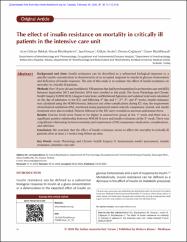| dc.contributor.author | Bakkal, Ayse Gulcan | |
| dc.contributor.author | Buyuksekerci, Murat | |
| dc.contributor.author | Gencay, Isin | |
| dc.contributor.author | Aydin, Gulcin | |
| dc.contributor.author | Caglayan, Osman | |
| dc.contributor.author | Buyukkocak, Unase | |
| dc.date.accessioned | 2021-01-14T18:11:08Z | |
| dc.date.available | 2021-01-14T18:11:08Z | |
| dc.date.issued | 2020 | |
| dc.identifier.citation | Bakkal, A.G., Büyükşekerci, M.,Gençay, I., Aydın, G., Çağlayan, O., Büyükkoçak, Ü.(2020).The effect of insulin resistance on mortality in critically ill patients in the intensive care unit. Indian Anaesth Forum [serial online] 21, 56-61. | en_US |
| dc.identifier.issn | 2589-7934 | |
| dc.identifier.issn | 0973-0311 | |
| dc.identifier.uri | https://doi.org/10.4103/TheIAForum.TheIAForum_91_19 | |
| dc.identifier.uri | https://hdl.handle.net/20.500.12587/12891 | |
| dc.description | WOS:000514461700010 | en_US |
| dc.description.abstract | Background and Aims: Insulin resistance can be described as a subnormal biological response to a specific insulin concentration or deterioration of an accepted response to insulin in glucose homeostasis and deficiency of insulin response. The aim of this study is to evaluate the effect of insulin resistance on mortality in critically ill patients. Methods: Over 18-year-old and nondiabetic 150 patients that had been hospitalized in an intensive care unit (ICU) between September 2013 and October 2014 were enrolled in this study. The Acute Physiology and Chronic Health Enquiry II (APACHE II), Glasgow Coma Scale, and Richmond Agitation and Sedation Scale were calculated on the day of admission to the ICU, and following 4th day and 1st, 2nd, 3rd, and 4th weeks. Insulin resistance was calculated using the HOMA formula. Infection and other complications during ICU stay, the requirement of mechanical ventilation (MV), nutritional status (parenteral and/or enteral), vasopressor, steroid, and insulin treatment were also recorded. Patients followed in the ICU were recorded as survivors and nonsurvivors. Results: Glucose levels were found to be higher in nonsurvivor group at the 1st week and there was a significant positive relationship between APACHE II score and insulin resistance at the 3rd week. There was a significant relationship between mortality and requirement of MV, vasopressor medication, complications, and infection. Conclusion: We conclude that the effect of insulin resistance seems to affect the mortality in critically ill patients after at least a 3 weeks long follow-up time. | en_US |
| dc.language.iso | eng | en_US |
| dc.publisher | INDIAN ANAESTHETISTS FORUM | en_US |
| dc.relation.isversionof | 10.4103/TheIAForum.TheIAForum_91_19 | en_US |
| dc.rights | info:eu-repo/semantics/openAccess | en_US |
| dc.subject | Acute Physiology and Chronic Health Enquiry II | en_US |
| dc.subject | homeostasis model assessment | en_US |
| dc.subject | insulin resistance | en_US |
| dc.subject | intensive care unit | en_US |
| dc.title | The effect of insulin resistance on mortality in critically ill patients in the intensive care unit | en_US |
| dc.type | article | en_US |
| dc.contributor.department | KKÜ | en_US |
| dc.identifier.volume | 21 | en_US |
| dc.identifier.issue | 1 | en_US |
| dc.identifier.startpage | 56 | en_US |
| dc.identifier.endpage | 61 | en_US |
| dc.relation.journal | INDIAN ANAESTHETISTS FORUM | en_US |
| dc.relation.publicationcategory | Makale - Uluslararası Hakemli Dergi - Kurum Öğretim Elemanı | en_US |
















